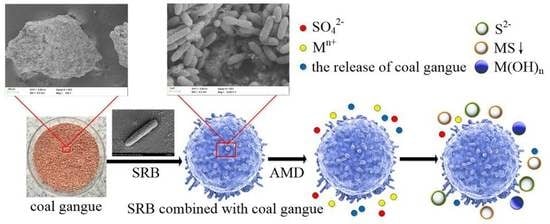Study on the Effectiveness of Sulfate-Reducing Bacteria Combined with Coal Gangue in Repairing Acid Mine Drainage Containing Fe and Mn
Abstract
:1. Introduction
2. Materials and Methods
2.1. Experimental Materials
2.2. Experimental Method and Apparatus
2.3. Detection and Analysis Methods
3. Results and Discussion
3.1. Dynamic Leaching Experiment Results of Four Kinds of Coal Gangues
3.2. Dynamic Experimental Results of Sulfate-Reducing Bacteria (SRB) Combined with Four Coal Gangues to Repair Acid Mine Drainage (AMD)
3.2.1. Changes in pH and Oxidation Reduction Potential (ORP) Values
3.2.2. Analysis of Chemical Oxygen Demand (COD) Removal Effect
3.2.3. Analysis of SO42− Removal Effect
3.2.4. Analysis of Fe2+ Removal Effect
3.2.5. Analysis of Mn2+ Removal Effect
3.2.6. Repair Effect of Columns 1–4 on AMD with Different Pollution Load
4. Instrumental Analysis and Characterization
4.1. Low-Temperature Nitrogen Adsorption Analysis
4.2. Scanning Electron Microscopy/Energy-Dispersive X-ray Spectroscopy (SEM/EDS) Analysis
4.3. X-ray Fluorescence (XRF) Analysis
4.4. Fourier Transform Infrared Spectroscopy (FTIR) Analysis
4.5. X-ray Diffraction (XRD) Analysis
5. Conclusions
- (1)
- After 16 days of leaching of Coal Gangue 1–4 under the condition of dynamic leaching capacity of 12 mL/h, the pH value, ORP value, SO42−, COD, Fe2+ and Mn2+ concentration of the leaching solution all tended to be stable. The average values of each index were as follows, Coal Gangue 4 > Coal Gangue 1 > Coal Gangue 2 > Coal Gangue 3. Among them, the average values of each index of Coal Gangue 4 leaching solution were 4.58, 199 mV, 13 mg/L, 341 mg/L, 21.32 mg/L and 2.42 mg/L, respectively.
- (2)
- The repair effect of SRB combined with Coal Gangue 1–4 on AMD was as follows: Column 3 > Column 2 > Column 1 > Column 4. In the second stage of influent, the removal efficiency of AMD by Column 1-4 was better and relatively stable. At this time, the average pH value and ORP value of the effluent of Column 3 were 9.09 and −262.83 mV, the highest removal percentage of COD and SO42− were 84.41% and 72.73%, respectively, the average removal percentage of Fe2+, Mn2+ were 98.70% and 79.97%, respectively. In the first four stages of influent, with the decrease of pH value, the increase of metal ion concentration and the decrease of nutrients in AMD, the growth activity of SRB was gradually inhibited. The alkalinity released by Coal Gangue 3 could effectively reduce the toxicity of AMD to SRB, which could remove AMD efficiently and steadily by SRB combined with Coal Gangue 3.
- (3)
- After introducing of the deionized water in the fifth stage, the indexes of the effluent of Column 1–4 tended to be stable, the pH was weak alkaline, and the average ORP value was stable at 20–34 mV. This system had a good fixation effect on SO42−, Fe2+ and Mn2+ ions in mine acid wastewater, and no secondary release of pollutants appeared.
- (4)
- Low temperature nitrogen adsorption, SEM/EDS, XRF, FTIR and XRD analysis showed that Coal Gangue 3 had the largest specific surface area and could adsorb and exchange more metal ions than the other three kinds of gangue. Coal Gangue 3 contained more alkaline minerals such as zeolite and calcite, which could not only precipitate metal ions in AMD, but also reduce the toxicity of AMD to SRB and ensure the normal growth of SRB. The SRB was attached to the surface of the coal gangue, and the SO42− in the AMD was converted into S2− by dissimilation. The S2− formed metal sulfide solid particle with the metal ions in the wastewater and adhered to the surface of the coal gangue. As a result, SRB combined with Coal Gangue 3 repaired AMD with the best result, and had the strongest anti-pollution load capacity.
Author Contributions
Funding
Acknowledgments
Conflicts of Interest
References
- Fan, C.; Li, S.; Elsworth, D.; Han, J.; Yang, Z. Experimental investigation on dynamic strength and energy dissipation characteristics of gas outburst–prone coal. Energy Sci. Eng. 2019. [Google Scholar] [CrossRef]
- Hwang, S.K.; Jho, E.H. Heavy metal and sulfate removal from sulfate-rich synthetic mine drainages using sulfate reducing bacteria. Sci. Total Environ. 2018, 635, 1308–1316. [Google Scholar] [CrossRef]
- Giachini, A.J.; Sulzbach, T.S.; Pinto, A.L.; Armas, R.D.; Cortez, D.H.; Silva, E.P.; Buzanello, E.B.; Soares, A.G.; Soares, C.; Rossi, M.J. Microbially-enriched poultry litter-derived biochar for the treatment of acid mine drainage. Arch. Microbiol. 2018, 200, 1227–1237. [Google Scholar] [CrossRef]
- Masindi, V.; Chatzisymeon, E.; Kortidis, I.; Foteinis, S. Assessing the sustainability of acid mine drainage (AMD) treatment in South Africa. Sci. Total Environ. 2018, 635, 793–802. [Google Scholar] [CrossRef] [Green Version]
- Masindi, V.; Akinwekomi, V.; Maree, J.P.; Muedi, K.L. Comparison of mine water neutralisation efficiencies of different alkaline generating agents. J. Environ. Chem. Eng. 2017, 5, 3903–3913. [Google Scholar] [CrossRef]
- Crafton, E.; Pritchard, C.; Guo, L.; Senko, J.M.; Cutright, T.J. Dynamics of Mn removal in an acid mine drainage treatment system over 13 years after installation. Environ. Earth Sci. 2019, 78, 10. [Google Scholar] [CrossRef]
- Qureshi, A.; Jia, Y.; Maurice, C.; Ohlander, B. Potential of fly ash for neutralisation of acid mine drainage. Environ. Sci. Pollut. Res. Int. 2016, 23, 17083–17094. [Google Scholar] [CrossRef] [PubMed]
- Nordstrom, D.K.; Blowes, D.W.; Ptacek, C.J. Hydrogeochemistry and microbiology of mine drainage: An update. Appl. Geochem. 2015, 57, 3–16. [Google Scholar] [CrossRef]
- Wang, B.; Wu, D.; Ekama, G.A.; Tsui, T.H.; Jiang, F.; Chen, G.H. Characterization of a new continuous gas-mixing sulfidogenic anaerobic bioreactor: Hydrodynamics and sludge granulation. Water Res. 2018, 135, 251–261. [Google Scholar] [CrossRef] [PubMed]
- Wu, J.; Niu, Q.; Li, L.; Hu, Y.; Mribet, C.; Hojo, T.; Li, Y.Y. A gradual change between methanogenesis and sulfidogenesis during a long-term UASB treatment of sulfate-rich chemical wastewater. Sci. Total Environ. 2018, 636, 168–176. [Google Scholar] [CrossRef]
- Li, X.; Lan, S.; Zhu, Z.; Zhang, C.; Zeng, G.; Liu, Y.; Cao, W.; Song, B.; Yang, H.; Wang, S.; et al. The bioenergetics mechanisms and applications of sulfate-reducing bacteria in remediation of pollutants in drainage: A review. Ecotoxicol. Environ. Saf. 2018, 158, 162–170. [Google Scholar] [CrossRef] [PubMed]
- Heidelberg, J.F.; Seshadri, R.; Haveman, S.A.; Hemme, C.L.; Paulsen, I.T.; Kolonay, J.F.; Eisen, J.A.; Ward, N.; Methe, B.; Brinkac, L.M. The genome sequence of the anaerobic, sulfate-reducing bacterium Desulfovibrio vulgaris Hildenborough. Nat. Biotechnol. 2004, 22, 554–559. [Google Scholar] [CrossRef] [PubMed]
- Odom, J.M.; Peck, H.D. Hydrogen cycling as a general mechanism for energy coupling in the sulfate-reducing bacteria, Desulfovibrio sp. FEMS Microbiol. Lett. 1981, 12, 47–50. [Google Scholar] [CrossRef]
- Pieulle, L.; Magro, V.; Hatchikian, E.C. Isolation and analysis of the gene encoding the pyruvate-ferredoxin oxidoreductase of Desulfovibrio africanus, production of the recombinant enzyme in Escherichia coli, and effect of carboxy-terminal deletions on its stability. J. Bacteriol. 1997, 179, 5684–5692. [Google Scholar] [CrossRef] [Green Version]
- Voordouw, G. Carbon monoxide cycling by Desulfovibrio vulgaris Hildenborough. J. Bacteriol. 2002, 184, 5903–5911. [Google Scholar] [CrossRef] [Green Version]
- Aubert, C.; Brugna, M.; Dolla, A.; Bruschi, M.; Giudiciorticoni, M.T. A sequential electron transfer from hydrogenases to cytochromes in sulfate-reducing bacteria. Biochim. Biophys. Acta 2000, 1476, 85–92. [Google Scholar] [CrossRef]
- Keller, K.L.; Wall, J.D. Genetics and molecular biology of the electron flow for sulfate respiration in Desulfovibrio. Front. Microbiol. 2011, 2, 135. [Google Scholar] [CrossRef] [Green Version]
- Broco, M.; Rousset, M.; Oliveira, S.; Rodrigues-Pousada, C. Deletion of flavoredoxin gene in Desulfovibrio gigas reveals its participation in thiosulfate reduction. FEBS Lett. 2005, 579, 4803–4807. [Google Scholar] [CrossRef] [Green Version]
- Qian, T.; Li, J. Synthesis of Na-A zeolite from coal gangue with the in-situ crystallization technique. Adv. Powder Technol. 2015, 26, 98–104. [Google Scholar] [CrossRef]
- Wu, H.; Wen, Q.; Hu, L.; Gong, M.; Tang, Z. Feasibility study on the application of coal gangue as landfill liner material. Waste Manag. 2017, 63, 161–171. [Google Scholar] [CrossRef]
- Liu, X.; Yang, X.; Du, H.; Wu, Y.; Zhang, X.; Zhang, J. Preparation and characterization of a porous silicate material using a CO2-storage material for CO2 adsorption. Powder Technol. 2018, 333, 138–152. [Google Scholar] [CrossRef]
- Jabłońska, B.; Kityk, A.V.; Busch, M.; Huber, P. The structural and surface properties of natural and modified coal gangue. J. Environ. Manag. 2017, 190, 80–90. [Google Scholar] [CrossRef] [PubMed]
- Qiu, R.; Cheng, F. Modification of waste coal gangue and its application in the removal of Mn2+ from aqueous solution. Water Sci. Technol. 2016, 74, 524–534. [Google Scholar] [CrossRef]
- Guo, X.; Yanrong, D.; Junzhen, D.; Ying, L.; Yang, D. Experimental treatment of acid mine drainage by the synergistic reaction with SRB and spontaneous combustion coal gangue. Non-Met. Min. 2016, 39, 28–31. [Google Scholar]
- Dong, Y.; Di, J.; Wang, X.; Xue, L.; Yang, Z.; Guo, X.; Li, M. Dynamic experimental study on treatment of acid mine drainage by bacteria supported in natural minerals. Energies 2020, 13, 439. [Google Scholar] [CrossRef] [Green Version]
- Dong, Y.; Di, J.; Wang, M.; Ren, Y. Experimental study on the treatment of acid mine drainage by modified corncob fixed SRB sludge particles. RSC Adv. 2019, 9, 19016–19030. [Google Scholar] [CrossRef] [Green Version]
- The State Environmental Protection Administration. Water and Wastewater Monitoring and Analysis Method, 4th ed.; China Environmental Science Press: Beijing, China, 2002.
- Wang, X.; Wang, Y.; Chu, Z.; Lu, X.; Chen, G.; Zha, F.; Cui, H.; Cheng, Y.; Zhang, R. Effects of coal gangue addition on the chemical fraction and bioavailability of heavy metals (Zn, Pb, Cd, Cr and Cu) in copper mine tailings. J. China Coal Soc. 2017, 42, 2688–2697. [Google Scholar]
- Ran, Z.; Liu, W.; Pan, Y.; Liu, W.; Gao, Z.; Zhao, Y. Influence of temperature on dynamic leaching characteristics of coal gangue. J. China Coal Soc. 2019, 44, 1239–1246. [Google Scholar]
- Sun, H.; Sheng, S.; Yang, Z.; Liu, H.; Jiao, X.; Wan, A. Analysis of Black-odor Factors of Lake Sediment and Elimination Strategies of Key Factor. Environ. Sci. Surv. 2019, 38, 12–20. [Google Scholar]
- Hao, T.; Xiang, P.; Mackey, H.R.; Chi, K.; Lu, H.; Chui, H.; van Loosdrecht, M.C.M.; Chen, G. A review of biological sulfate conversions in wastewater treatment. Water Res. 2014, 65, 1–21. [Google Scholar] [CrossRef]
- Hwang, T.; Neculita, C.M.; Han, J.I. Biosulfides precipitation in weathered tailings amended with food waste-based compost and zeolite. J. Environ. Qual. 2012, 41, 1857–1864. [Google Scholar] [CrossRef] [PubMed] [Green Version]
- Neufeld, R.D.; Ropelewski, L.; Acheson, M. Sewage as a mixed organic substrate for desulfurization bacteria. Proc. Water Environ. Fed. 2012, 2012, 265–274. [Google Scholar] [CrossRef]
- Chang, Y.; Chang, Y.; Hung, C.; Lee, J.; Liao, H.; Chou, H. Microbial community analysis of anaerobic bio-corrosion in different ORP profiles. Int. Biodeterior. Biodegrad. 2014, 95, 93–101. [Google Scholar] [CrossRef]
- Wan, H.; Su, S.; Zhu, J.; Wan, X.; Ge, C. Study on the factors affecting growth of the sulphate-reducing bacteria and its biological desulfurization capability. J. Chem. Eng. Chin. Univ. 2004, 18, 218–223. [Google Scholar]
- Wang, G.; Zhang, R.; Fu, J.; Lu, Y.; Su, Y. Research on the constructed wetland modified substrates for the advanced treatment of sewage. Ind. Water Treat. 2016, 36, 73–78. [Google Scholar]
- Liu, Z.; Li, L.; Li, Z.; Tian, X. Removal of sulfate and heavy metals by sulfate reducing bacteria in an expanded granular sludge bed reactor. Environ. Technol. 2017, 39, 1814–1822. [Google Scholar] [CrossRef] [PubMed]
- Yilmaz, T.; Erdirencelebi, D.; Berktay, A. Effect of COD/SO42- ratio on anaerobic treatment of landfill leachate during the start-up period. Environ. Technol. 2012, 33, 313–320. [Google Scholar] [CrossRef]
- Bijmans, M.F.; Dopson, M.; Peeters, T.W.; Lens, P.N.; Buisman, C.J. Sulfate reduction at pH 5 in a high-rate membrane bioreactor: Reactor performance and microbial community analyses. J. Microbiol. Biotechnol. 2009, 19, 698–708. [Google Scholar] [CrossRef]
- Kushkevych, I.; Dordevic, D.; Vitezova, M. Toxicity of hydrogen sulfide toward sulfate-reducing bacteria Desulfovibrio piger Vib-7. Arch. Microbiol. 2019, 201, 389–397. [Google Scholar] [CrossRef]
- Barbosa, L.P.; Costa, P.F.; Bertolino, S.M.; Silva, J.C.C.; Guerra-Sá, R.; Leão, V.A.; Teixeira, M.C. Nickel, manganese and copper removal by a mixed consortium of sulfate reducing bacteria at a high COD/sulfate ratio. World J. Microbiol. Biotechnol. 2014, 30, 2171–2180. [Google Scholar] [CrossRef]
- Vossoughi, M.; Shakeri, M.; Alemzadeh, I. Performance of anaerobic baffled reactor treating synthetic wastewater influenced by decreasing COD/SO4 ratios. Chem. Eng. Process. Process Intensif. 2003, 42, 811–816. [Google Scholar] [CrossRef]
- Sabumon, P.C. Development of enhanced sulphidogenesis process for the treatment of wastewater having low COD/SO42- ratio. J. Hazard. Mater. 2008, 159, 616–625. [Google Scholar] [CrossRef]
- Lu, X.; Zhen, G.; Ni, J.; Hojo, T.; Kubota, K.; Li, Y.Y. Effect of influent COD/SO42- ratios on biodegradation behaviors of starch wastewater in an upflow anaerobic sludge blanket (UASB) reactor. Bioresour. Technol. 2016, 214, 175–183. [Google Scholar] [CrossRef]
- Li, D.; Chen, H. Study development of wastewater adsorbent prepared by coal gangue. J. Luoyang Inst. Sci. Technol. (Nat. Sci. Ed.) 2012, 22, 6–9. [Google Scholar]
- Miao, Z.; He, H.; Tan, T.; Zhang, T.; Tang, J.; Yang, Y.; Shi, K.; Tang, J. Biotreatment of Mn2+ and Pb2+ with Sulfate-Reducing Bacterium Desulfuromonas alkenivorans S-7. J. Environ. Eng. 2018, 144, 1–7. [Google Scholar] [CrossRef]
- Yue, Z.; Li, Q.; Li, C.; Chen, T.; Wang, J. Component analysis and heavy metal adsorption ability of extracellular polymeric substances (EPS) from sulfate reducing bacteria. Bioresour. Technol. 2015, 194, 399–402. [Google Scholar] [CrossRef]
- Comte, S.; Guibaud, G.; Baudu, M. Biosorption properties of extracellular polymeric substances (EPS) towards Cd, Cu and Pb for different pH values. J. Hazard. Mater. 2008, 151, 185–193. [Google Scholar] [CrossRef]
- Li, W.W.; Yu, H.Q. Insight into the roles of microbial extracellular polymer substances in metal biosorption. Bioresour. Technol. 2014, 160, 15–23. [Google Scholar] [CrossRef]
- Wang, L.; Chen, T.; Chang, D.; Liu, H.; Chen, D. Cd2+ adsorption from aqueous solutions by desulfurization products of manganese nodule leached residue. Acta Petrol. Mineral. 2011, 30, 1001–1006. [Google Scholar]
- Jia, J.; Lan, B.; Xie, X.; Wu, D.; Tang, Y.; Wang, J. Relationship between solubility of sulfides and solution pH value. J. Jilin Univ. (Earth Sci. Ed.) 2001, 31, 241–246. [Google Scholar]
- Guo, X.; Fan, G.; Di, J.; Dong, Y. Research on treatment of acid mine drainage containing Fe2+ and Mn2+ by modified spontaneous combustion coal gangue. Non-Met. Min. 2015, 38, 67–70. [Google Scholar]
- Zhang, M.; Wang, H. Preparation of immobilized sulfate reducing bacteria (SRB) granules for effective bioremediation of acid mine drainage and bacterial community analysis. Min. Eng. 2016, 92, 63–71. [Google Scholar] [CrossRef]
- Sahinkaya, E.; Gunes, F.M.; Ucar, D.; Kaksonen, A.H. Sulfidogenic fluidized bed treatment of real acid mine drainage water. Bioresour. Technol. 2011, 102, 683–689. [Google Scholar] [CrossRef]
- Sahinkaya, E.; Yucesoy, Z. Biotreatment of acidic zinc- and copper-containing wastewater using ethanol-fed sulfidogenic anaerobic baffled reactor. Bioprocess Biosyst. Eng. 2010, 33, 989–997. [Google Scholar] [CrossRef]
- Bai, H.; Kang, Y.; Quan, H.; Han, Y.; Sun, J.; Feng, Y. Treatment of acid mine drainage by sulfate reducing bacteria with iron in bench scale runs. Bioresour. Technol. 2013, 128, 818–822. [Google Scholar] [CrossRef]
- Peng, B.; Li, X.; Zhao, W.; Yang, L. Study on the release characteristics of chlorine in coal gangue under leaching conditions of different pH values. Fuel 2018, 217, 427–433. [Google Scholar] [CrossRef]
- Orrego-Ruiz, J.A.; Cabanzo, R.; Mejía-Ospino, E. Study of Colombian coals using photoacoustic Fourier transform infrared spectroscopy. Int. J. Coal Geol. 2011, 85, 307–310. [Google Scholar] [CrossRef]
- Zhou, C.; Liu, G.; Yan, Z.; Fang, T.; Wang, R. Transformation behavior of mineral composition and trace elements during coal gangue combustion. Fuel 2012, 97, 644–650. [Google Scholar] [CrossRef]
- Gramp, J.P.; Bigham, J.M.; Sasaki, K.; Tuovinen, O.H. Formation of Ni- and Zn-sulfides in cultures of sulfate-reducing bacteria. Geomicrobiol. J. 2007, 24, 609–614. [Google Scholar] [CrossRef]
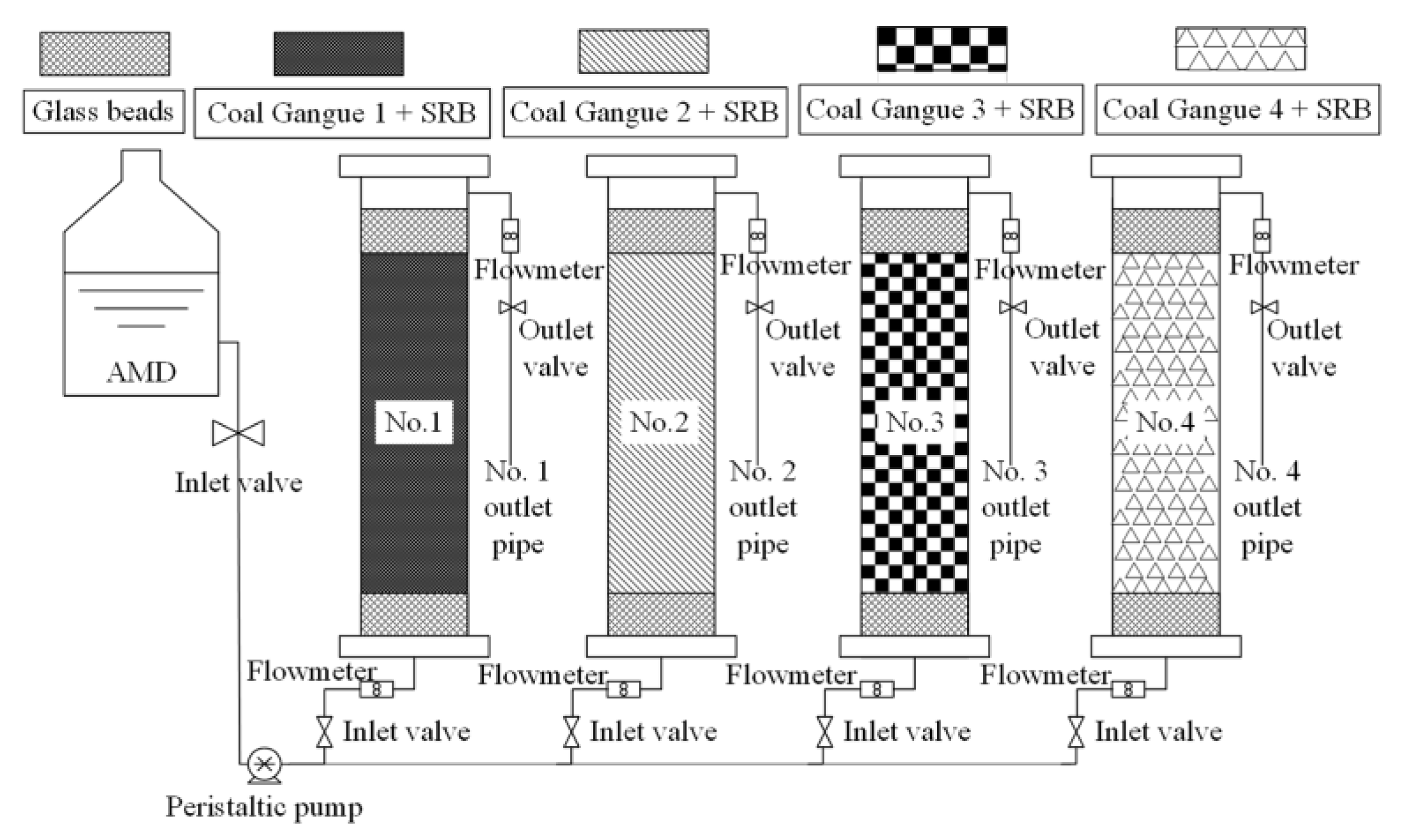


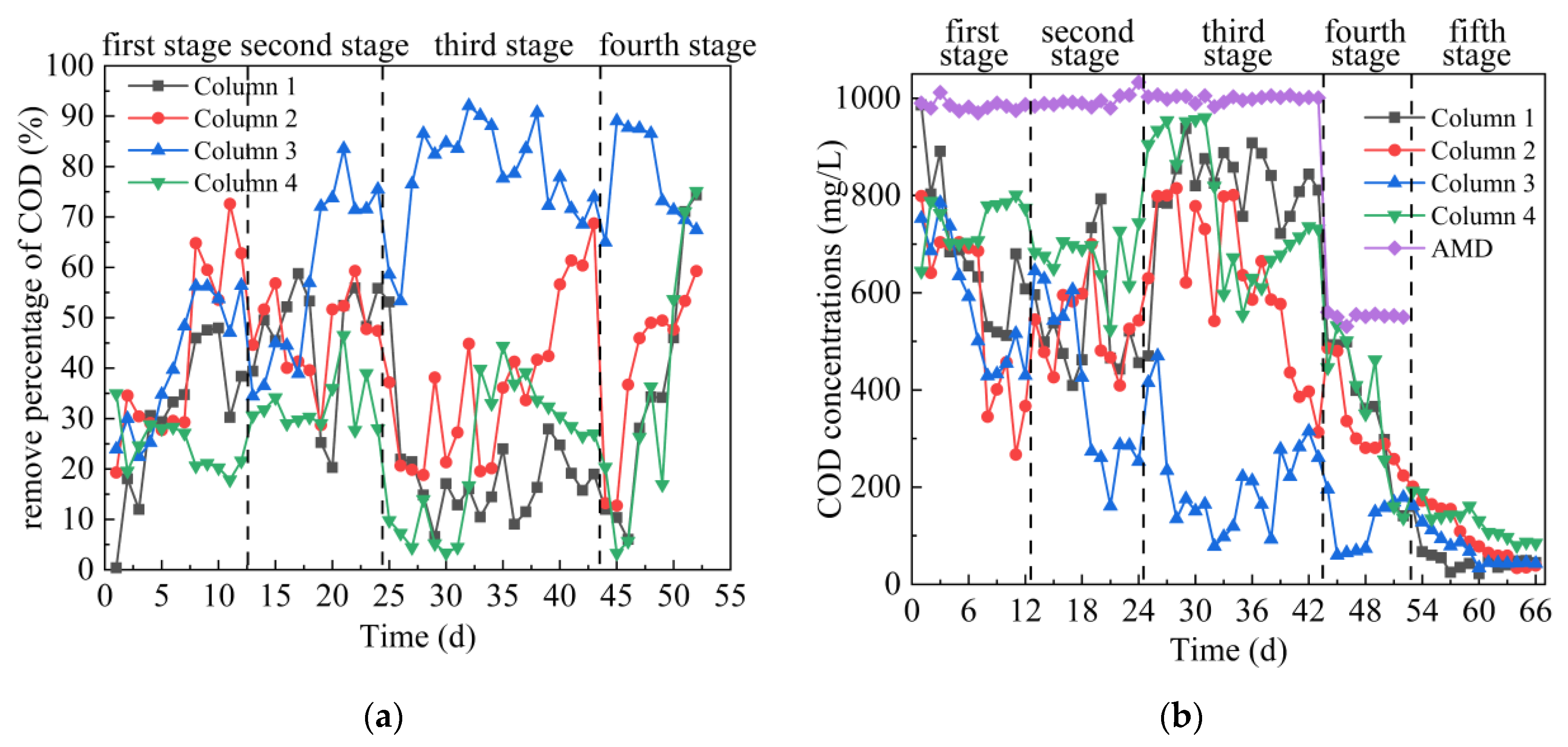


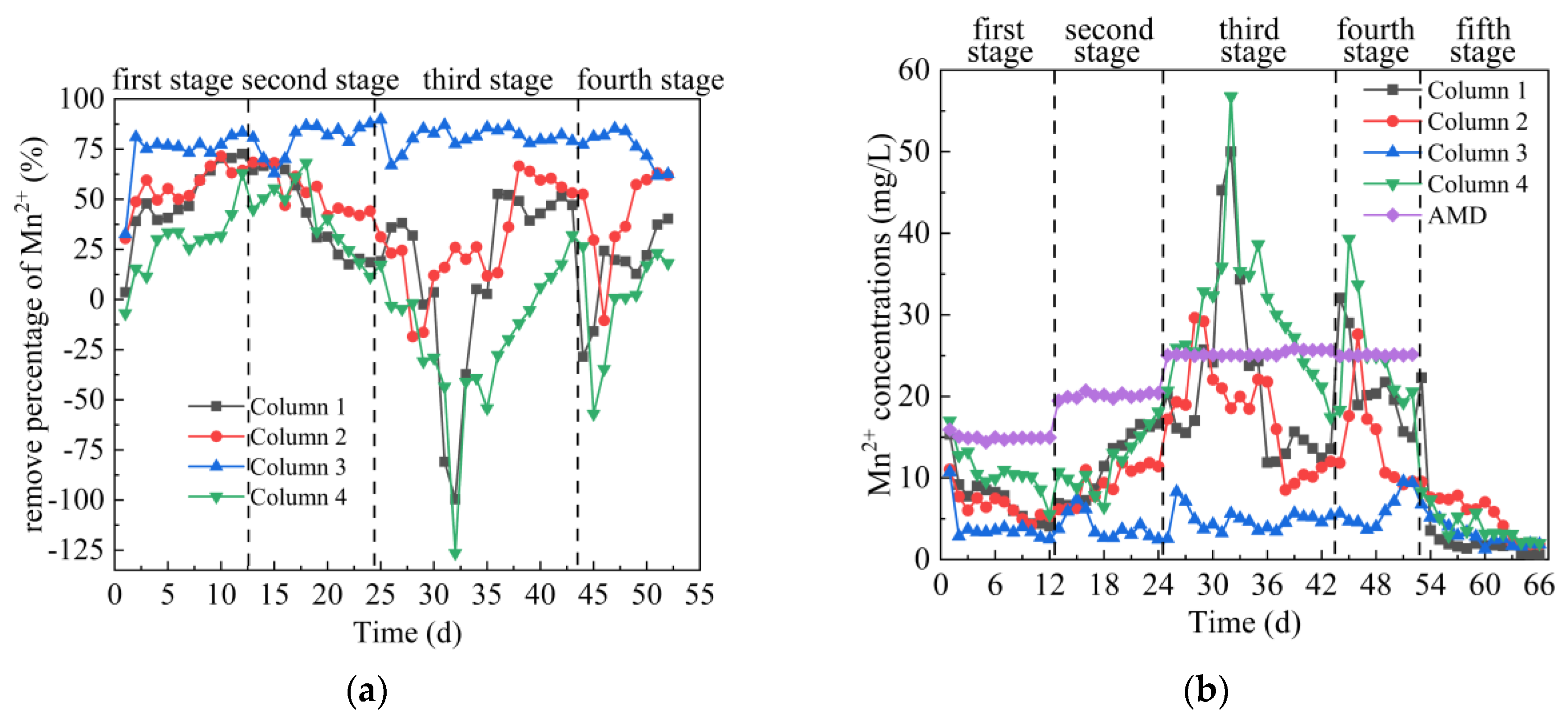
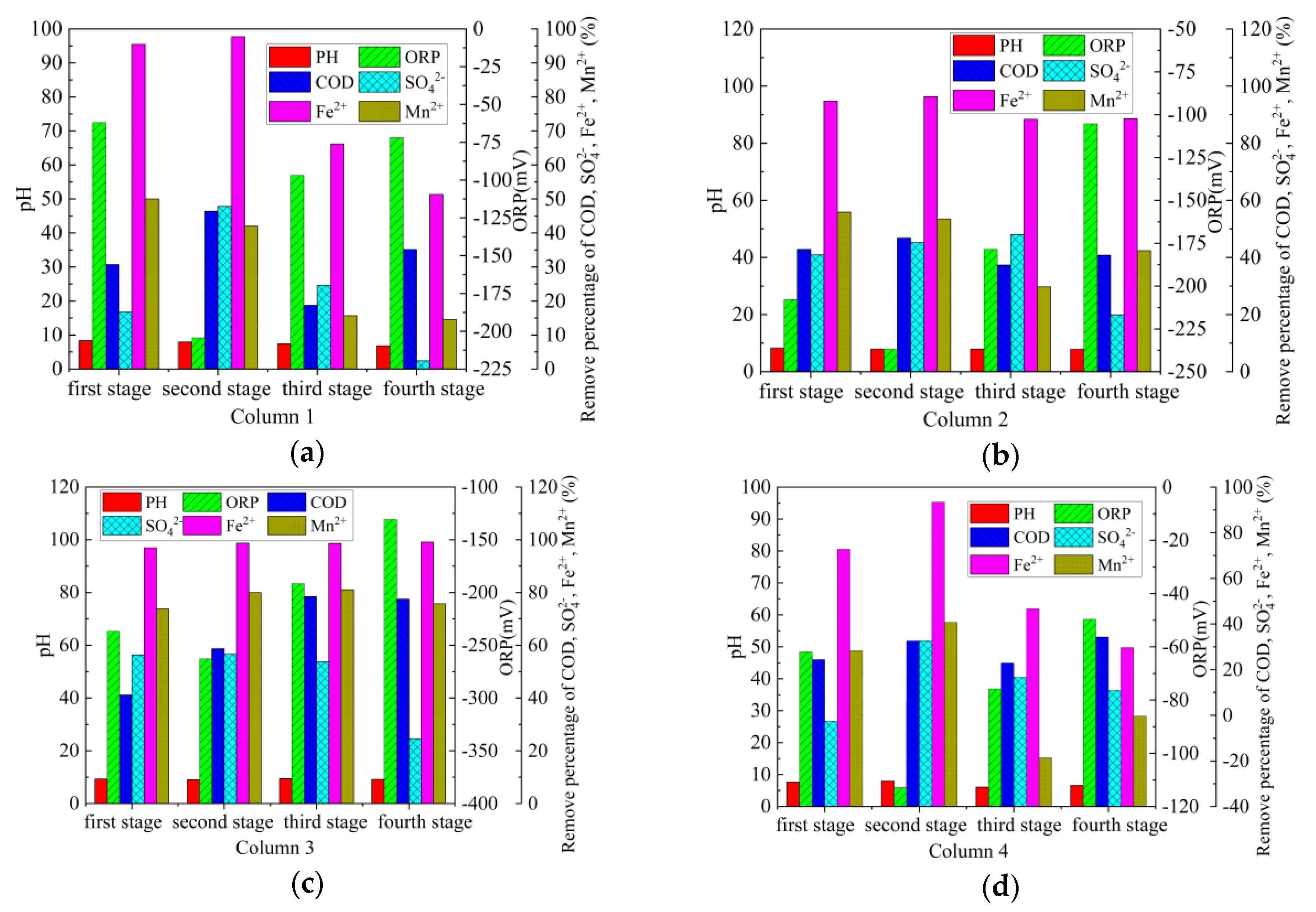
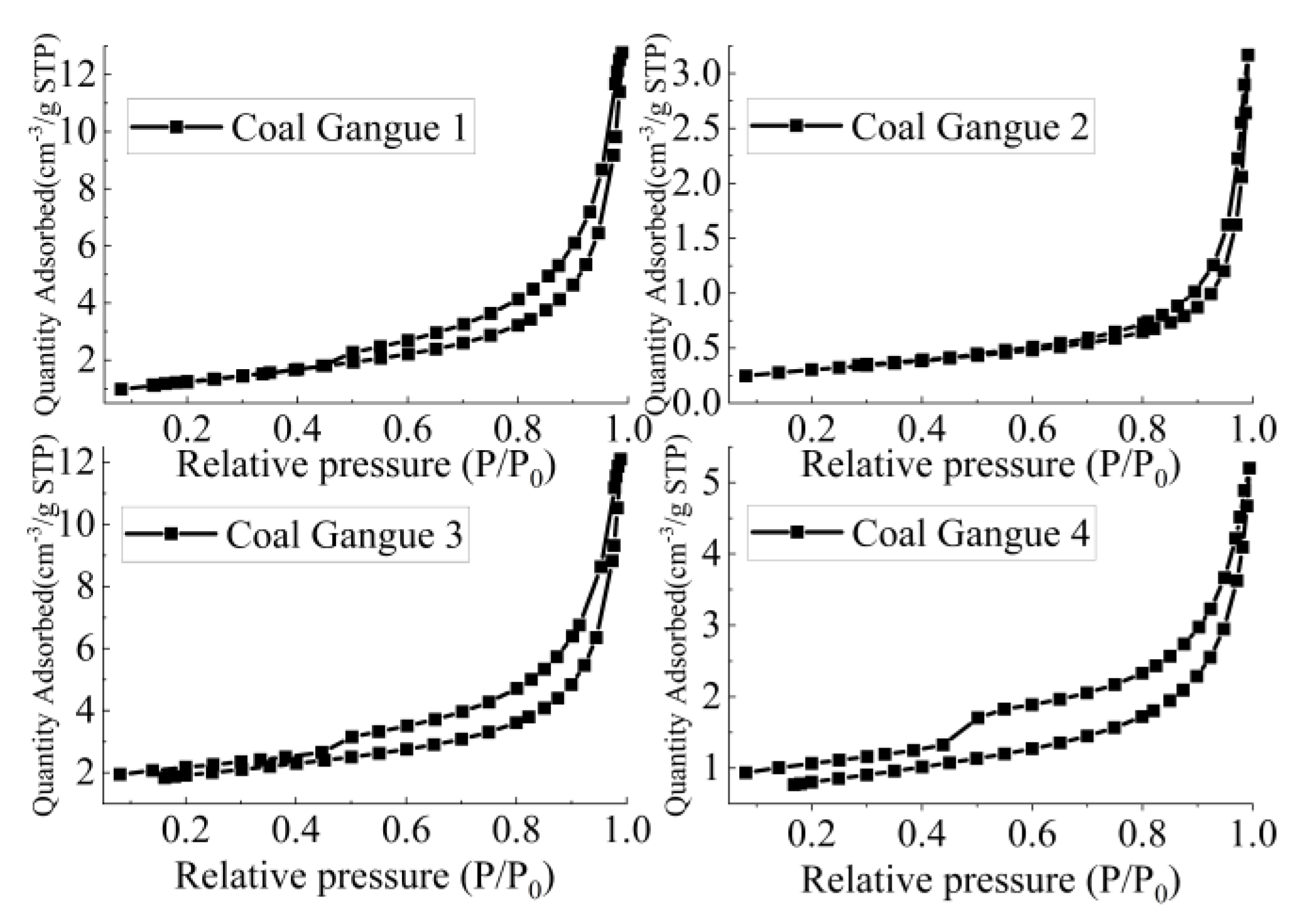
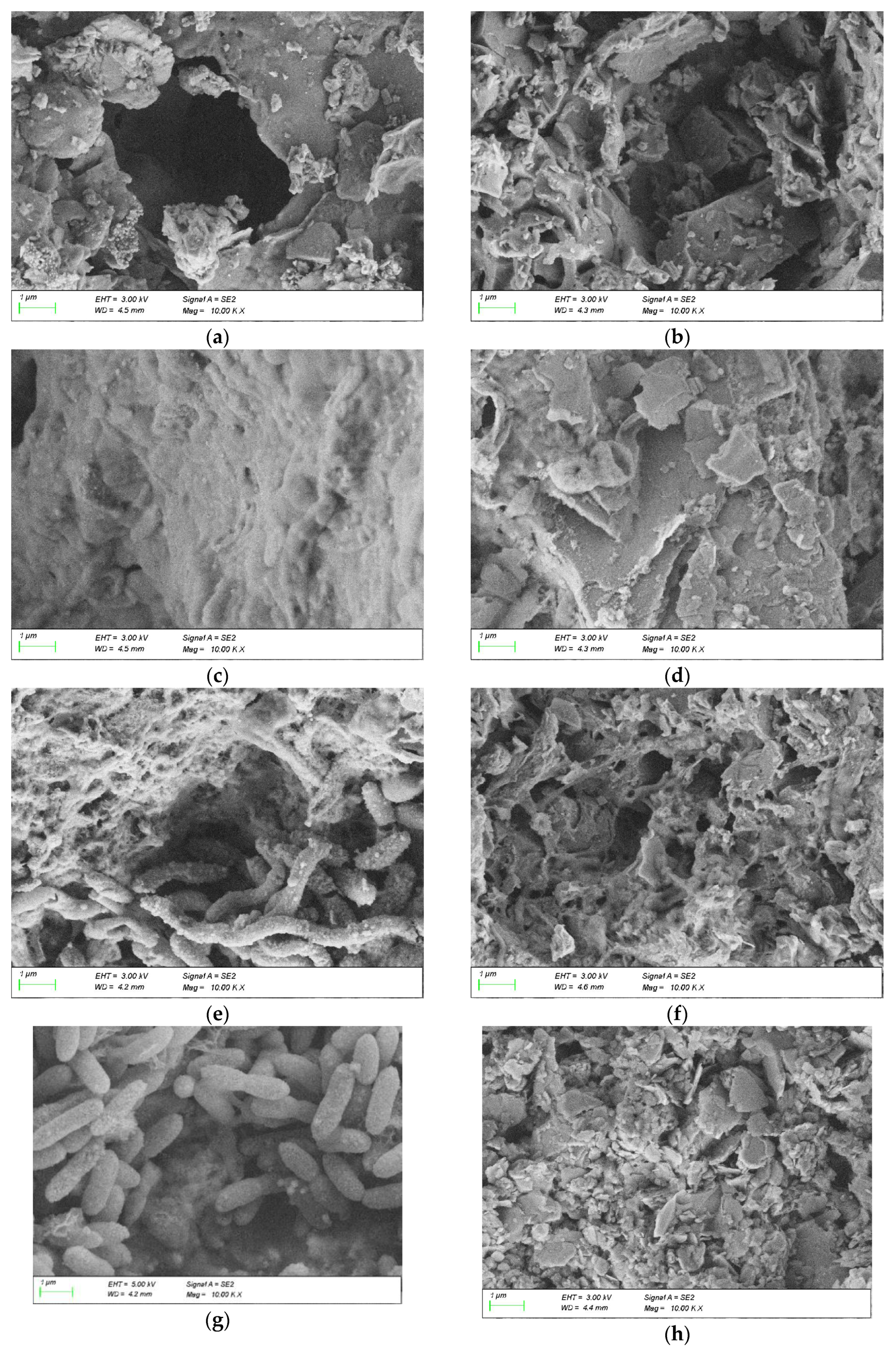
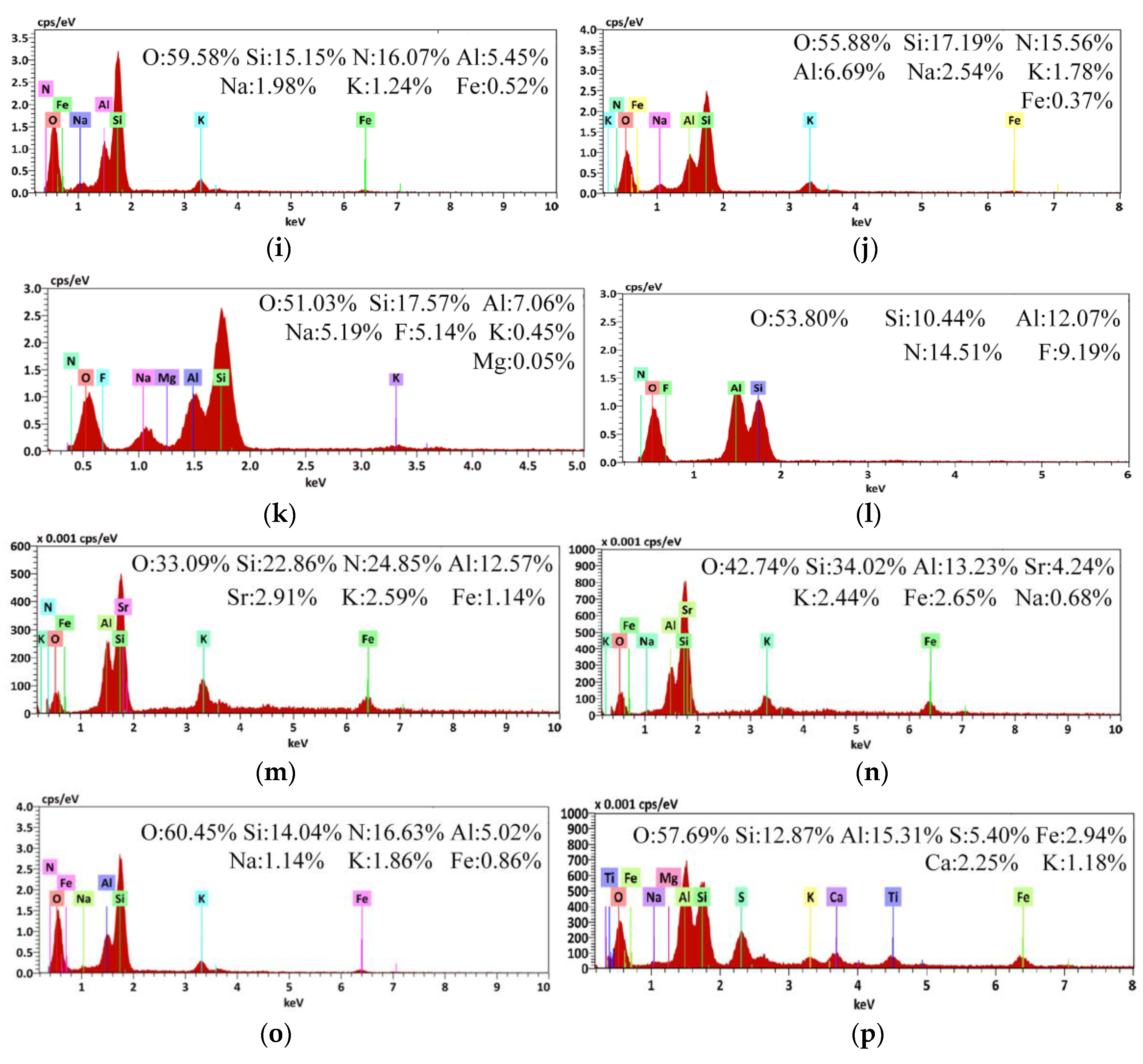

| Constituent | SiO2 | Al2O3 | Fe2O3 | MgO | CaO | Na2O | K2O | TiO2 | MnO | P2O5 | SO3 | CO2 |
|---|---|---|---|---|---|---|---|---|---|---|---|---|
| Gangue 1 | 58.287 | 16.239 | 7.05 | 2.114 | 3.187 | 1.838 | 3.086 | 0.699 | 0.156 | 0.19 | 1.998 | 2.504 |
| Gangue 2 | 63.265 | 16.117 | 4.393 | 1.602 | 0.821 | 2.392 | 3.055 | 0.761 | 0.048 | 0.164 | 0.193 | 0.645 |
| Gangue 3 | 62.008 | 16.889 | 5.353 | 2.85 | 1.931 | 1.492 | 2.655 | 0.807 | 0.082 | 0.208 | 0.231 | 1.517 |
| Gangue 4 | 42.992 | 36.091 | 6.61 | 0.751 | 0.294 | 0.137 | 0.221 | 0.896 | 0.017 | 0.045 | 7.19 | 0.231 |
| Project | pH | SO42− (mg/L) | Fe2+ (mg/L) | Mn2+ (mg/L) | COD (mg/L) | PO43− (mg/L) | NH4+ (mg/L) |
|---|---|---|---|---|---|---|---|
| First stage | 5.5 | 1000 | 50 | 15 | 1000 | 191 | 118 |
| Second stage | 3.5 | 1200 | 75 | 20 | 1000 | 191 | 118 |
| Third stage | 3 | 1300 | 125 | 25 | 1000 | 191 | 118 |
| Fourth stage | 3 | 1300 | 125 | 25 | 550 | 191 | 118 |
| Project | Brunauer-Emmett-Teller (BET) Specific Surface Area (m2/g) | Barrett-Joyner-Halenda (BJH) Pore Volume (cm3/g) | BET Aperture (nm) |
|---|---|---|---|
| Coal Gangue 1 | 4.5486 | 0.020461 | 173.6552 |
| Coal Gangue 2 | 1.0063 | 0.004797 | 194.8004 |
| Coal Gangue 3 | 6.1727 | 0.018129 | 121.2907 |
| Coal Gangue 4 | 2.7403 | 0.008038 | 117.4198 |
| Constituent | SiO2 | Al2O3 | Fe2O3 | MgO | CaO | Na2O | K2O | TiO2 | MnO | P2O5 | SO3 | CO2 |
|---|---|---|---|---|---|---|---|---|---|---|---|---|
| Gangue 1 | 61.365 | 16.719 | 6.866 | 1.896 | 1.443 | 1.856 | 3.294 | 0.631 | 0.116 | 0.311 | 0.463 | 1.134 |
| Gangue 2 | 63.844 | 15.978 | 4.707 | 1.545 | 0.718 | 2.431 | 3.166 | 0.77 | 0.042 | 0.19 | 0.215 | 0.564 |
| Gangue 3 | 62.139 | 17.572 | 5.191 | 2.087 | 1.562 | 1.401 | 2.644 | 0.784 | 0.149 | 0.476 | 0.457 | 1.227 |
| Gangue 4 | 44.666 | 33.632 | 7.613 | 0.35 | 0.251 | 0.226 | 0.489 | 0.882 | 0.039 | 0.244 | 7.608 | 0.197 |
© 2020 by the authors. Licensee MDPI, Basel, Switzerland. This article is an open access article distributed under the terms and conditions of the Creative Commons Attribution (CC BY) license (http://creativecommons.org/licenses/by/4.0/).
Share and Cite
Dong, Y.; Di, J.; Yang, Z.; Zhang, Y.; Wang, X.; Guo, X.; Li, Z.; Jiang, G. Study on the Effectiveness of Sulfate-Reducing Bacteria Combined with Coal Gangue in Repairing Acid Mine Drainage Containing Fe and Mn. Energies 2020, 13, 995. https://doi.org/10.3390/en13040995
Dong Y, Di J, Yang Z, Zhang Y, Wang X, Guo X, Li Z, Jiang G. Study on the Effectiveness of Sulfate-Reducing Bacteria Combined with Coal Gangue in Repairing Acid Mine Drainage Containing Fe and Mn. Energies. 2020; 13(4):995. https://doi.org/10.3390/en13040995
Chicago/Turabian StyleDong, Yanrong, Junzhen Di, Zhenhua Yang, Yuanling Zhang, Xianjun Wang, Xuying Guo, Zhennan Li, and Guoliang Jiang. 2020. "Study on the Effectiveness of Sulfate-Reducing Bacteria Combined with Coal Gangue in Repairing Acid Mine Drainage Containing Fe and Mn" Energies 13, no. 4: 995. https://doi.org/10.3390/en13040995
APA StyleDong, Y., Di, J., Yang, Z., Zhang, Y., Wang, X., Guo, X., Li, Z., & Jiang, G. (2020). Study on the Effectiveness of Sulfate-Reducing Bacteria Combined with Coal Gangue in Repairing Acid Mine Drainage Containing Fe and Mn. Energies, 13(4), 995. https://doi.org/10.3390/en13040995



